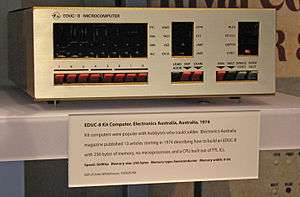EDUC-8
|
EDUC-8 Microcomputer on display at the Computer History Museum. | |
| Manufacturer | Electronics Australia |
|---|---|
| Type | microcomputer |
| Release date | August 1974 |
| Memory | 256 bytes of RAM |
The EDUC-8, pronounced "educate", was an early microcomputer kit published by Electronics Australia in a series of articles starting in August 1974 and continuing to August 1975. Electronics Australia initially believed that it was the first such kit, but later discovered that Radio-Electronics had just beaten it with their Mark-8 by one month. However, Electronics Australia staff believed that their TTL design was superior to the Mark-8, as it did not require the purchase of an expensive microprocessor chip.
The EDUC-8 was an 8 bit bit-serial design with 256 bytes of RAM. The internal clock speed was 500 kHz, with an instruction speed of approximately 10 kHz, due to the bit-serial implementation. The instruction set was based on the DEC PDP-8.
Unlike the MITS Altair 8800, the EDUC-8 included two serial input and two serial output ports at the back of the computer. The EDUC-8 also had front panel lights and switches to program the computer. The later articles included a variety of peripherals, allowing the computer to interface to a keypad, octal display, paper tape loader, paper tape puncher, printer, keyboard, music player, teleprinter, magnetic tape recorder and alphanumeric display. The articles were collected into a book,[1] where additional information was published detailing how to expand the number of I/O ports to 256, adding up to 32KB of additional memory, and using the computer to control various switches.
References
- ↑ EDUC-8 An Educational Microcomputer System For The Home Constructor and College Student, by Jamieson Rowe published by Electronics Australia
External links
- EDUC-8 kit computer at the Computer History Museum.
- The Electronics Australia EDUC-8 microcomputer
- Educ-8 Documentation
- sworld EDUC-8 Micromputer
